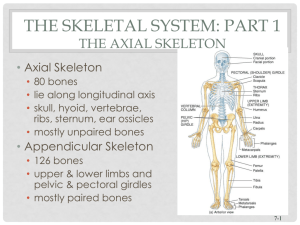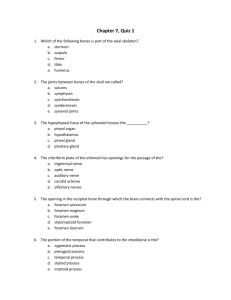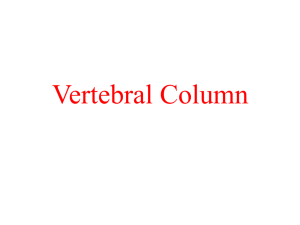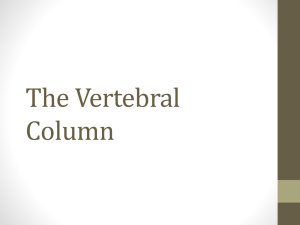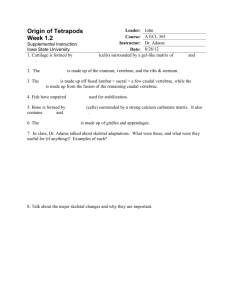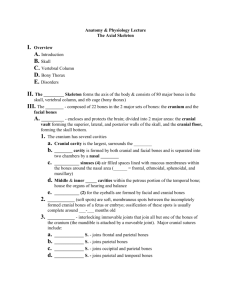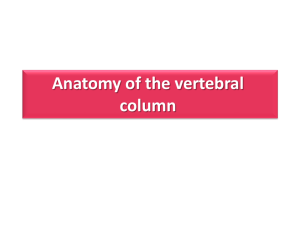Facial bones
advertisement
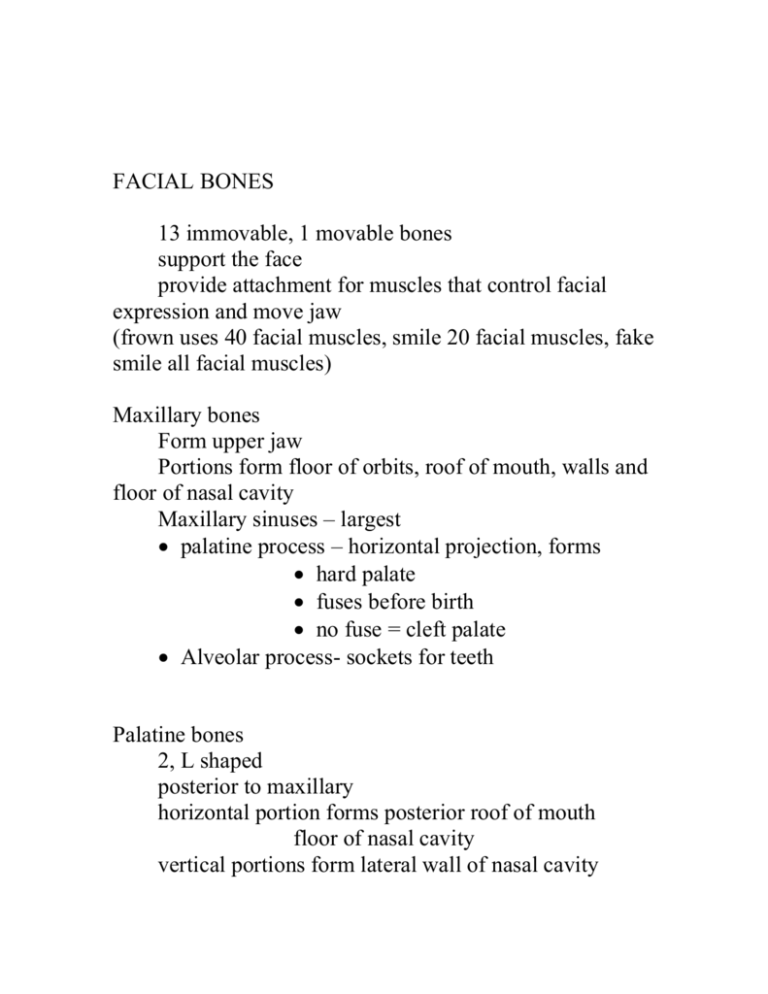
FACIAL BONES 13 immovable, 1 movable bones support the face provide attachment for muscles that control facial expression and move jaw (frown uses 40 facial muscles, smile 20 facial muscles, fake smile all facial muscles) Maxillary bones Form upper jaw Portions form floor of orbits, roof of mouth, walls and floor of nasal cavity Maxillary sinuses – largest palatine process – horizontal projection, forms hard palate fuses before birth no fuse = cleft palate Alveolar process- sockets for teeth Palatine bones 2, L shaped posterior to maxillary horizontal portion forms posterior roof of mouth floor of nasal cavity vertical portions form lateral wall of nasal cavity Vomer – finishes the nasal septum along with perpendicular plate Zygomatic Bones Cheekbones Part of orbit Temporal process – extends to temporal bone Zygomatic arch – cheek bone Nasal bones 2 small rectangular bones forms bridge of nose, between orbits Lacrimal bones 2 tiny, fingernail sized bones posterior and lateral to nasal bones anterior to ethmoid forms part of medial wall of orbits Inferior nasal conchae 2 thin scroll like bones inferior to superior and middle nasal conchae of ethmoid turbinates – the superior, middle and inferior nasal conchae – warms and moistens the air before it reaches lungs, Mandible – only movable facial bone Lower jaw Mandibular condyle – articulates with temporal bone at mandibular fossa of temporal bone Alveolar processes – sockets for teeth mental foramen – in mandible below first molar DDS injects anesthetics to block o Pain during dental work Mandibular foramen in ramus – DDS also uses for Point of anesthetics VERTEBRAL COLUMN Comprised of vertebrae Intervertebral discs – fibrocartilage Vertebral canal – foramen through vertebrae, protect Spinal cord 7 cervical, 12 thoracic, 5 lumbar, 5 sacral(fused = sacrum) 3-5 fused = coccyx(cuckoo, from it’s resemblance to cuckoo’s beak) Vertebral regions correspond to the 4 curves Cervical curve –bends anteriorly, concave Thoracic curve – bends posteriorly, convex Lumbar curve – bends anteriorly, concave Sacral curve – bends posteriorly, convex Curves give added strength, maintain balance, absorb shock Newborns, 1 single convex curve Cervical curve develops when baby learns To hold its head @ 1 month Lumbar curve develops when baby can stand/walk @ 9 mos to 1yr. ANATOMY OF TYPICAL VERTEBRA Body – wgt bearing part Attaches to intervertebral discs Vertebral arch – extends from body, posteriorly Forms the vertebral foramen Transverse process – lateral projections - articulate with ribs - sites of muscle attachement Superior and inferior articulating processes - like the transverse process only above and below the transverse - superior articulates with inferior - process of superior vertebra - inferior process articulates with - superior process of inferior vertebra CERVICAL VERTEBRAE Different from all other vertebra Smaller and lighter Include a transverse foramen for arteries to brain Bifid spinous process 1st and 2nd c.vert = atlas and axis 1st (atlas) articulates with occipital condyles no body large superior articulating process allows us to nod “yes” 2nd c.vert = axis has a body with odontoid process projects into ring of atlas allows us to say “no” C-7 vertebra prominens, large, nonbifid spinous process Seen and felt at base of neck 12 THORACIC VERTEBRAE long, pointed spinous processes, project downward articulate with ribs smooth facets on side of body for heads of ribs inferior demifacet of a TV will articulate with rib with superior demifacef of lower TV T-10 thru T-12 whole facets on bodies 5 LUMBAR VERTEBRAE thickest and largest able to provide support spinous process is quadrilateral in shape projects nearly straight out point of attachment for largest back muscle(latissimus dorsi) SACRUM Delta shaped bone Strong foundation for pelvic girdle Between 2 hip bones – forms posterior pelvic cavity 4 pair of foramina for nerves and BV sacral canal – continuation of vertebral canal sacral hiatus – 4th and 5th sacral vert don’t meet point of caudal anesthesia located by sacral cornea (bony prominences) COCCYX Fusion of coccygeal vertebrae Attaches to sacrum by ligaments Spina bifida – usually in lumbar vert. Laminae(base of spinous process) fail to unite Vertebral canal is open Protrusion of spinal cord Paralysis, loss of urinary bladder control No reflexesb
